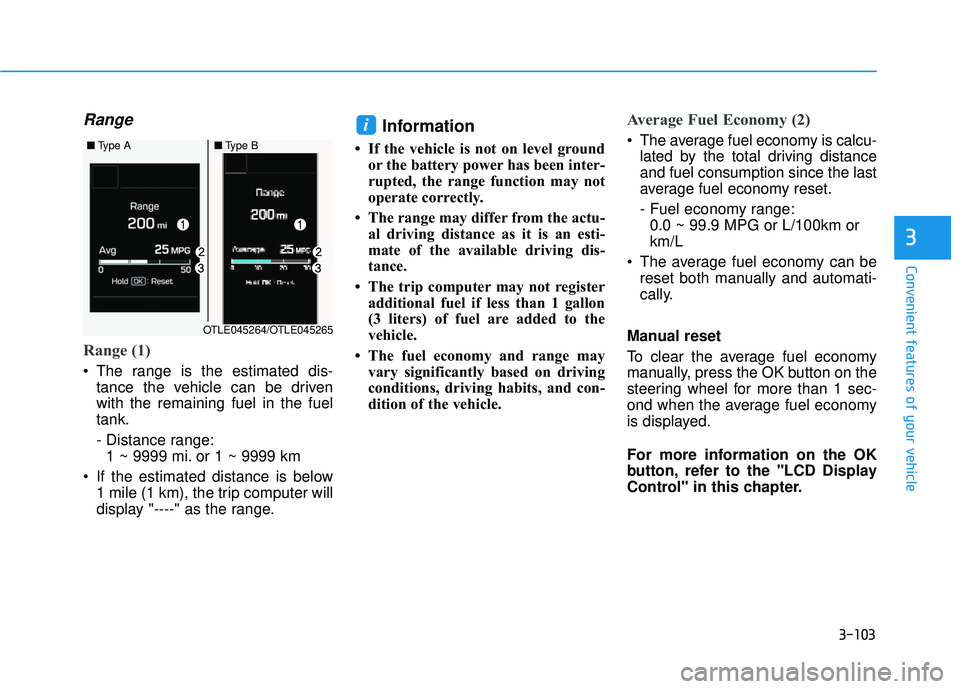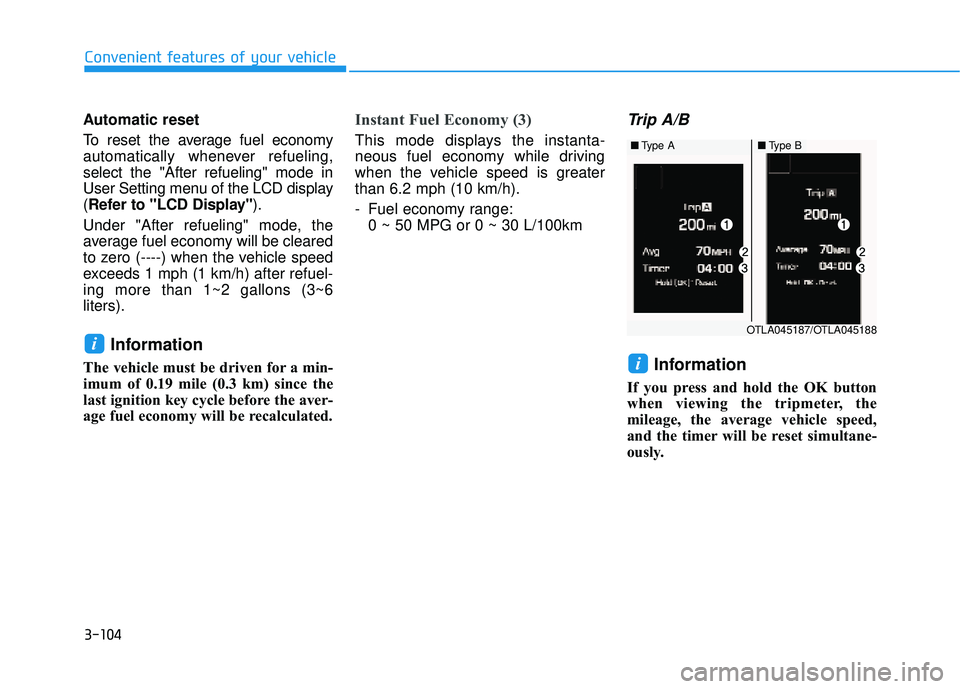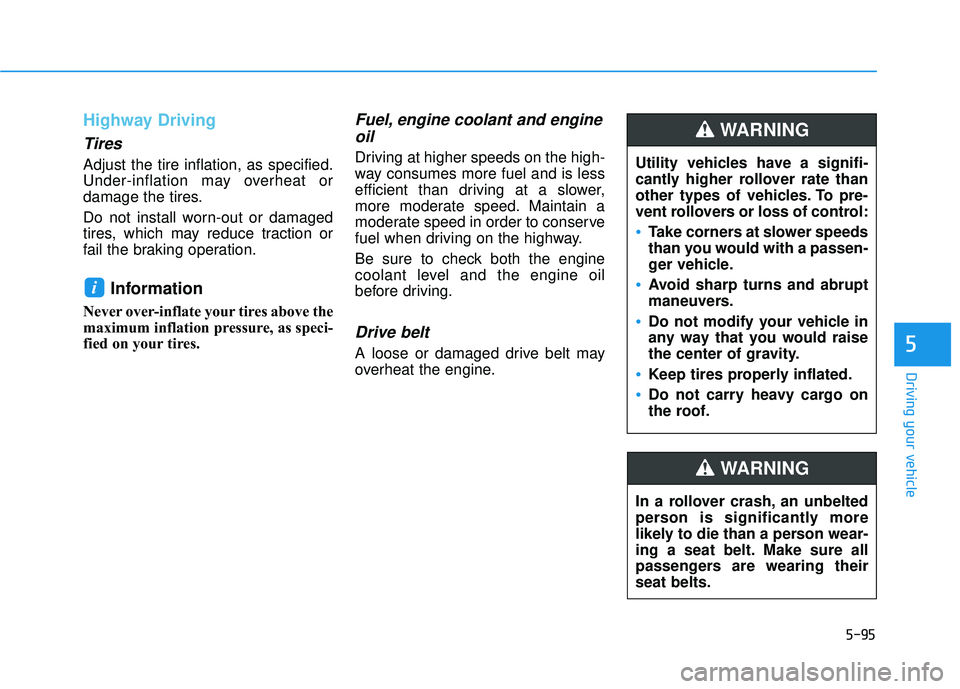Page 197 of 586

3-103
Convenient features of your vehicle
Range
Range (1)
The range is the estimated dis-tance the vehicle can be driven
with the remaining fuel in the fuel
tank.
- Distance range:1 ~ 9999 mi. or 1 ~ 9999 km
If the estimated distance is below 1 mile (1 km), the trip computer will
display "----" as the range.
Information
• If the vehicle is not on level groundor the battery power has been inter-
rupted, the range function may not
operate correctly.
• The range may differ from the actu- al driving distance as it is an esti-
mate of the available driving dis-
tance.
• The trip computer may not register additional fuel if less than 1 gallon
(3 liters) of fuel are added to the
vehicle.
• The fuel economy and range may vary significantly based on driving
conditions, driving habits, and con-
dition of the vehicle.
Average Fuel Economy (2)
The average fuel economy is calcu-lated by the total driving distance
and fuel consumption since the last
average fuel economy reset.
- Fuel economy range:0.0 ~ 99.9 MPG or L/100km or
km/L
The average fuel economy can be reset both manually and automati-
cally.
Manual reset
To clear the average fuel economy
manually, press the OK button on the
steering wheel for more than 1 sec-
ond when the average fuel economy
is displayed.
For more information on the OK
button, refer to the "LCD Display
Control" in this chapter.i
3
■ Type A■Type B
OTLE045264/OTLE045265
Page 198 of 586

3-104
Automatic reset
To reset the average fuel economy
automatically whenever refueling,
select the "After refueling" mode in
User Setting menu of the LCD display
(Refer to "LCD Display" ).
Under "After refueling" mode, the
average fuel economy will be cleared
to zero (----) when the vehicle speed
exceeds 1 mph (1 km/h) after refuel-
ing more than 1~2 gallons (3~6
liters).
Information
The vehicle must be driven for a min-
imum of 0.19 mile (0.3 km) since the
last ignition key cycle before the aver-
age fuel economy will be recalculated.
Instant Fuel Economy (3)
This mode displays the instanta-
neous fuel economy while driving
when the vehicle speed is greater
than 6.2 mph (10 km/h).
- Fuel economy range: 0 ~ 50 MPG or 0 ~ 30 L/100km
Trip A/B
Information
If you press and hold the OK button
when viewing the tripmeter, the
mileage, the average vehicle speed,
and the timer will be reset simultane-
ously.
i
i
Convenient features of your vehicle
OTLA045187/OTLA045188
■ Type A■Type B
Page 200 of 586
3-106
Digital speedometer
This message shows the speed of
the vehicle (in mph).
Driving info display
At the end of each driving cycle, the
Driving Info message is displayed.
This display shows the trip distance,
the average fuel economy, and the
remaining vehicle range.
This information is displayed for a
few seconds when you turn off the
ignition, and then goes off automati-
cally. The information is calculated
for each ignition cycle.
If the estimated remaining vehicle
range is below 1 mile (1.6 km), the
range will display as "----" and a "Low
Fuel" warning message will be dis-
played.
Information
If "Sunroof Open" warning message
is displayed in the cluster, the Driving
Information message may not be dis-
played.
i
Convenient features of your vehicle
■Type A■Type B
OLF044418N/OLF044419N
OTLA045193/OTLA045194
■ Type A■Type A
Page 415 of 586

5-95
Driving your vehicle
5
Highway Driving
Tires
Adjust the tire inflation, as specified.
Under-inflation may overheat or
damage the tires.
Do not install worn-out or damaged
tires, which may reduce traction or
fail the braking operation.
Information
Never over-inflate your tires above the
maximum inflation pressure, as speci-
fied on your tires.
Fuel, engine coolant and engineoil
Driving at higher speeds on the high-
way consumes more fuel and is less
efficient than driving at a slower,
more moderate speed. Maintain a
moderate speed in order to conserve
fuel when driving on the highway.
Be sure to check both the engine
coolant level and the engine oil
before driving.
Drive belt
A loose or damaged drive belt may
overheat the engine.
i
Utility vehicles have a signifi-
cantly higher rollover rate than
other types of vehicles. To pre-
vent rollovers or loss of control:
Take corners at slower speeds
than you would with a passen-
ger vehicle.
Avoid sharp turns and abrupt
maneuvers.
Do not modify your vehicle in
any way that you would raise
the center of gravity.
Keep tires properly inflated.
Do not carry heavy cargo on
the roof.
WARNING
In a rollover crash, an unbelted
person is significantly more
likely to die than a person wear-
ing a seat belt. Make sure all
passengers are wearing their
seat belts.
WARNING
Page 579 of 586

I-6
Exhaust emission control system....................................7-97
Explanation of scheduled maintenance items.................7-24
Exterior care....................................................................7-89\
Exterior lights ...............................................................3-107
Exterior overviewFront ........................................................................\
.....2-2
Rear ........................................................................\
......2-3
Flat tire Jack and tools .............................................................6-15
Jack label ....................................................................6-22\
Tire Mobility Kit ........................................................6-22
Use of compact spare tires .........................................6-20
Floor mat anchor(s).......................................................3-157
Fluid Brake/clutch fluid .......................................................7-33
Washer fluid ...............................................................7-34
Front lamps ...................................................................3-115
Front seats ........................................................................\
.2-6
Fuel filler door ................................................................3-58
Fuel gauge .......................................................................3\
-65
Fuel requirements .............................................................F-7
Fuse/relay panel description Instrument panel fuse panel .......................................7-66
Engine compartment fuse panel .................................7-69 Fuses ........................................................................\
.......7-60
Blade type fuse ...........................................................7-65
Cartridge type fuse .....................................................7-65
Engine compartment panel fuse replacement ............7-63
Fuse switch .................................................................7-62
Fuse/relay panel description .......................................7-66
Instrument panel fuse replacement.............................7-61
Main fuse ....................................................................7-64\
Multi fuse ...................................................................7-64
Gauges........................................................................\
.....3-63
Glove box......................................................................3-\
151
Hazard warning flasher .....................................................6-2
Hazardous driving conditions .........................................5-92
Head restraints ................................................................2-15
Headlamp delay function ..............................................3-113
Headlamp position ........................................................3-109
Headlight bulb replacement ............................................7-72
Heater Automatic climate control system............................3-133
Manual climate control system ................................3-123
Height adjustment ...........................................................2-25
High beam operation.....................................................3-109
Highway driving .............................................................5-95
Index
F
G
H